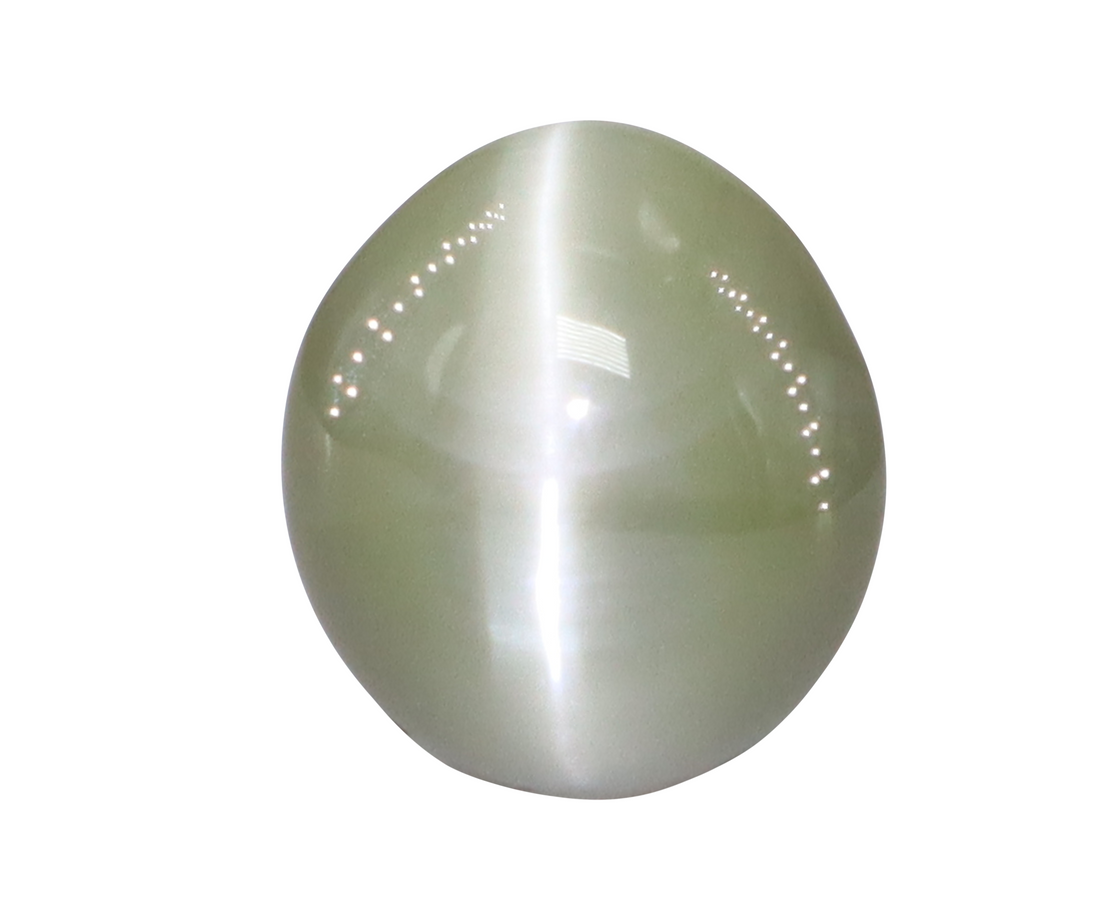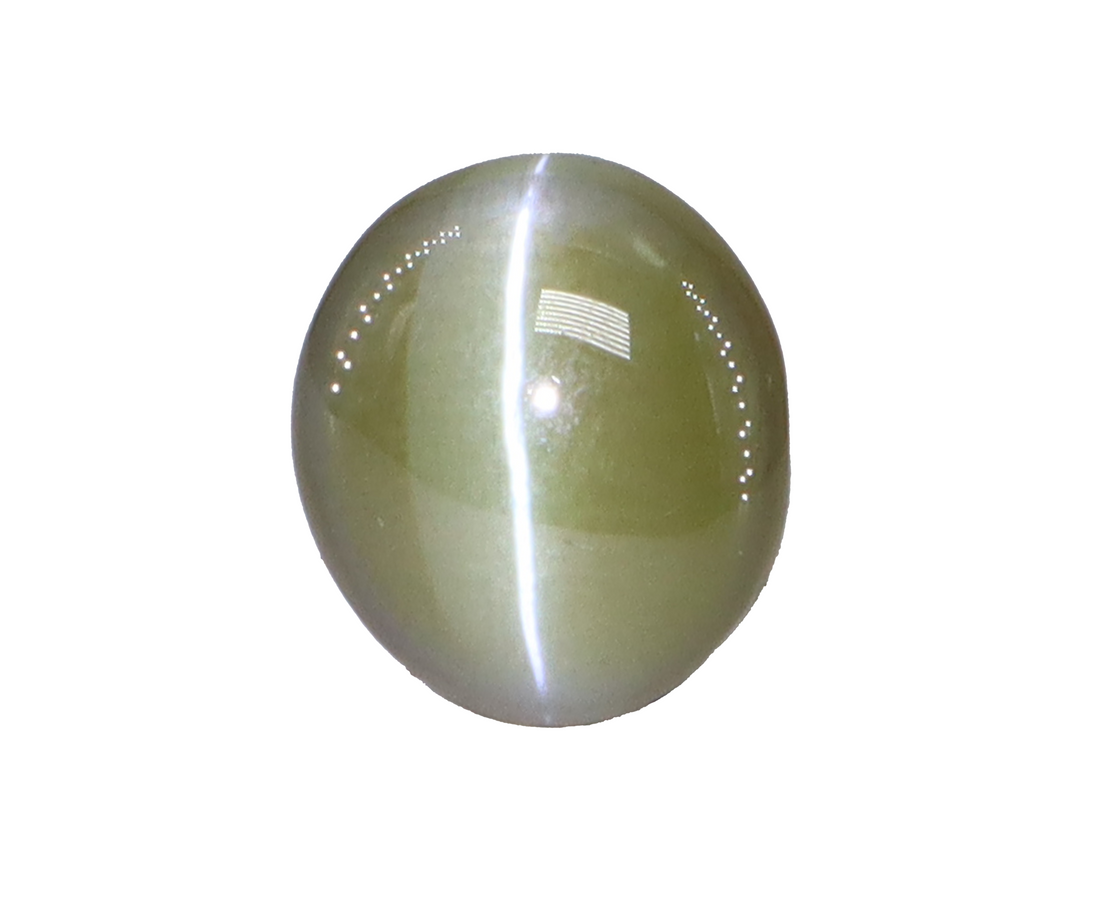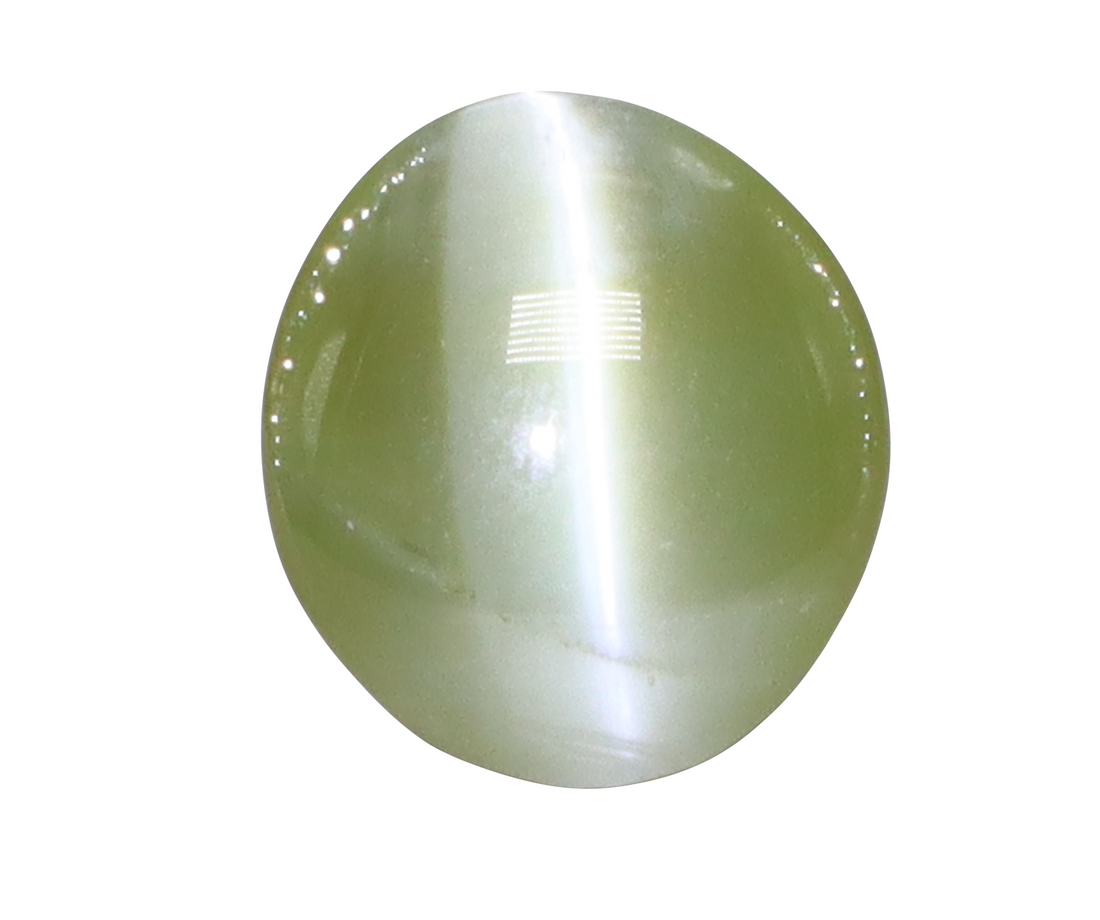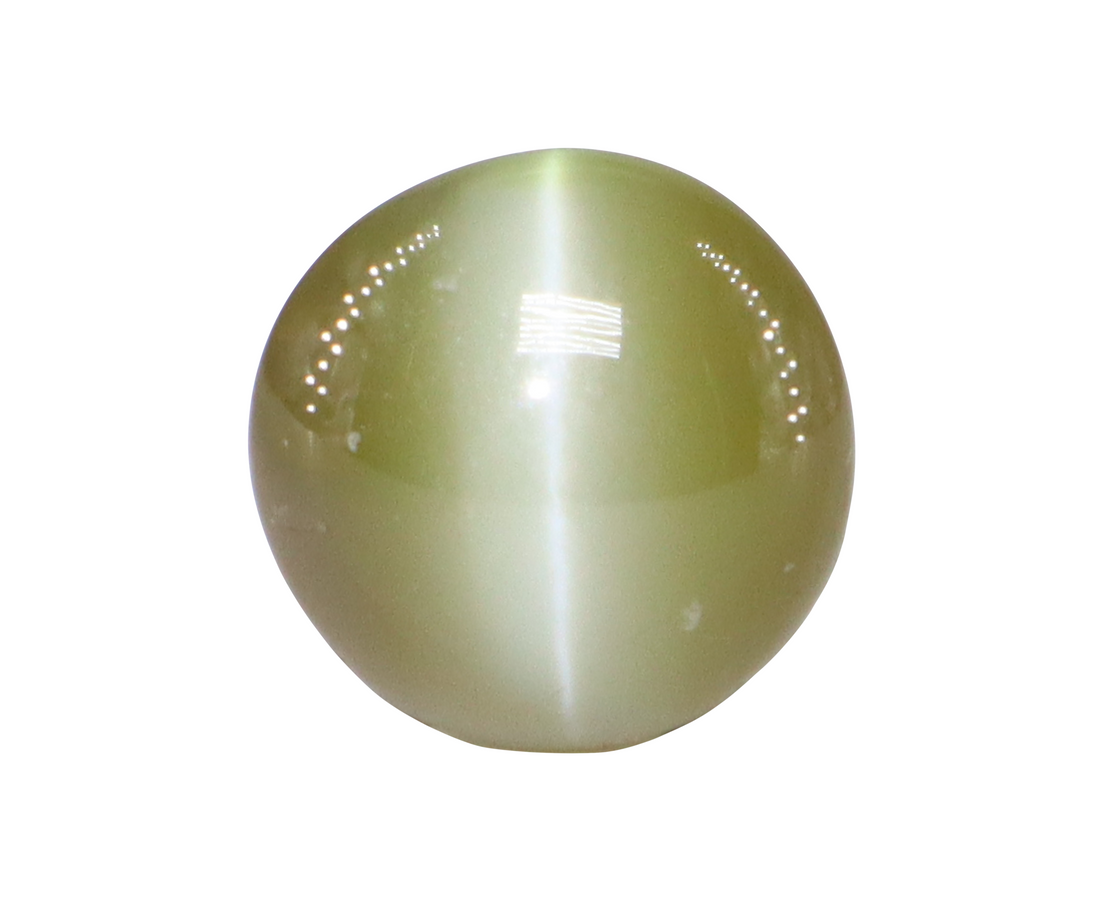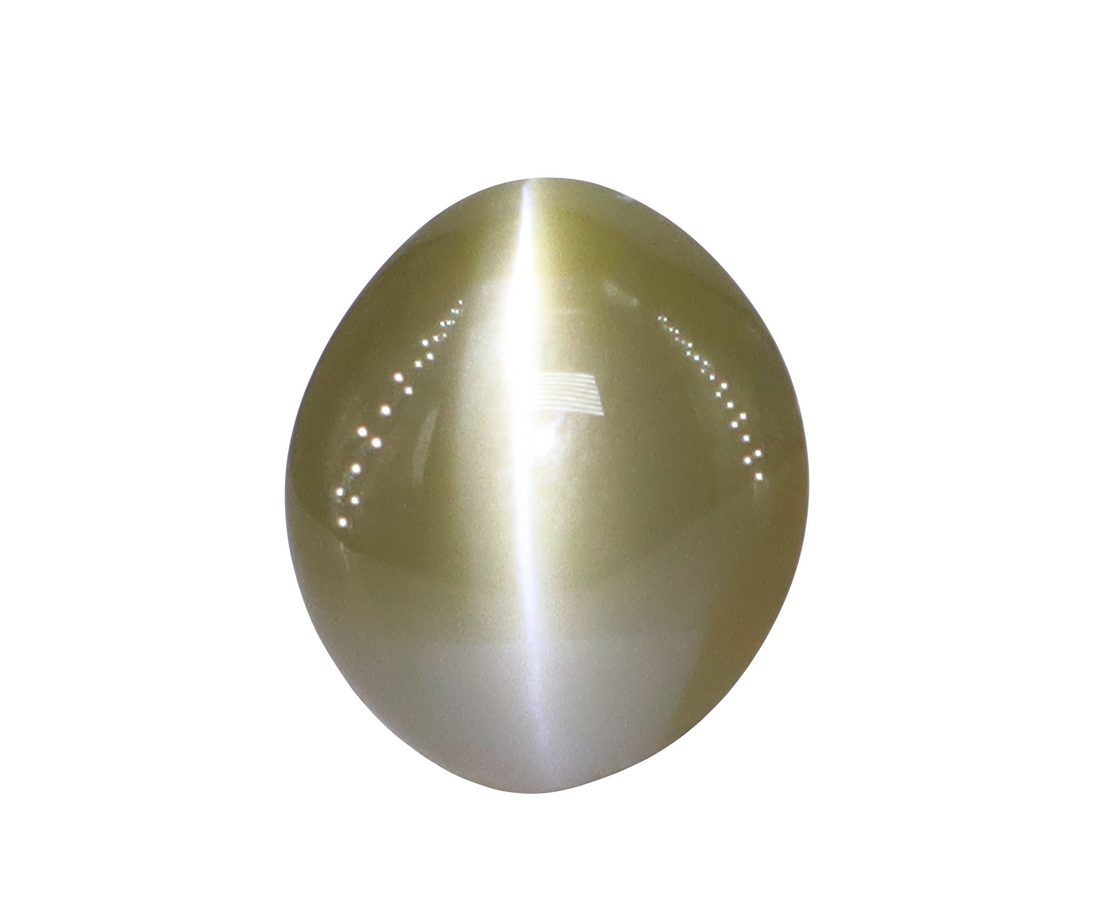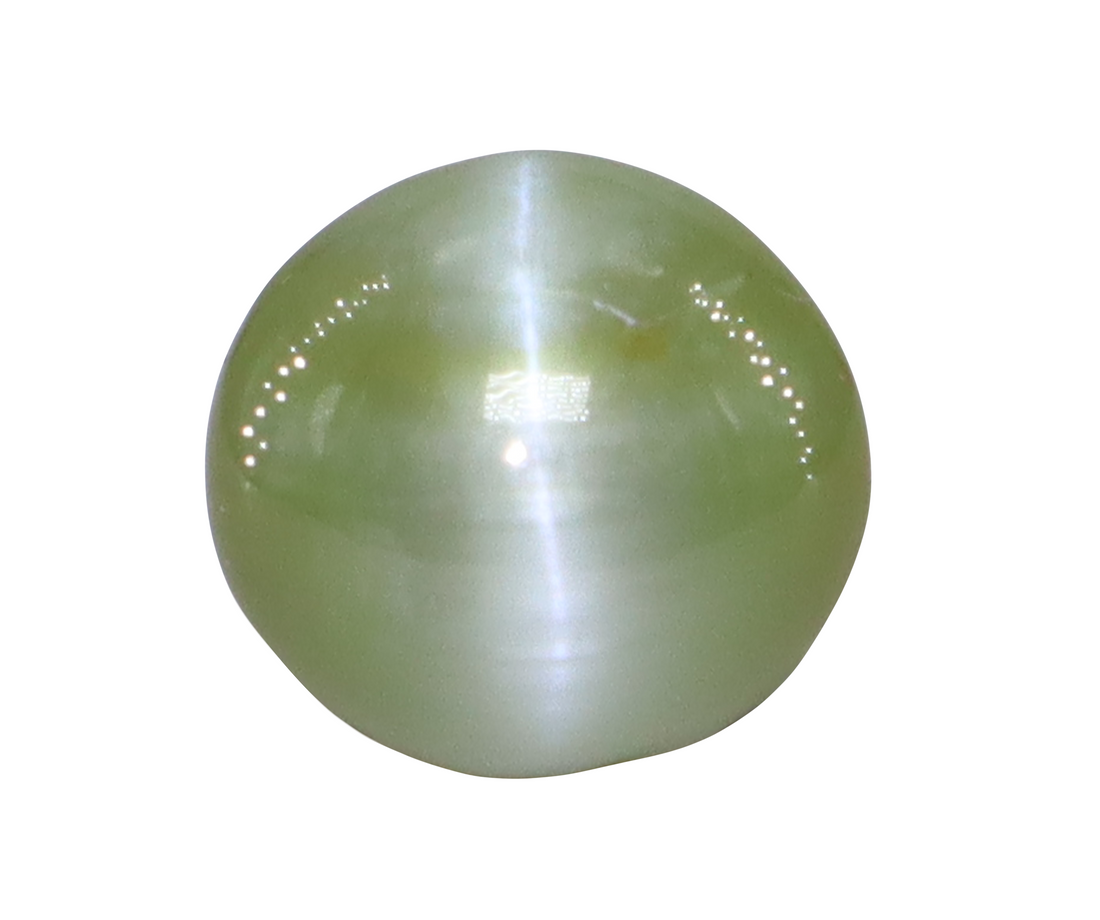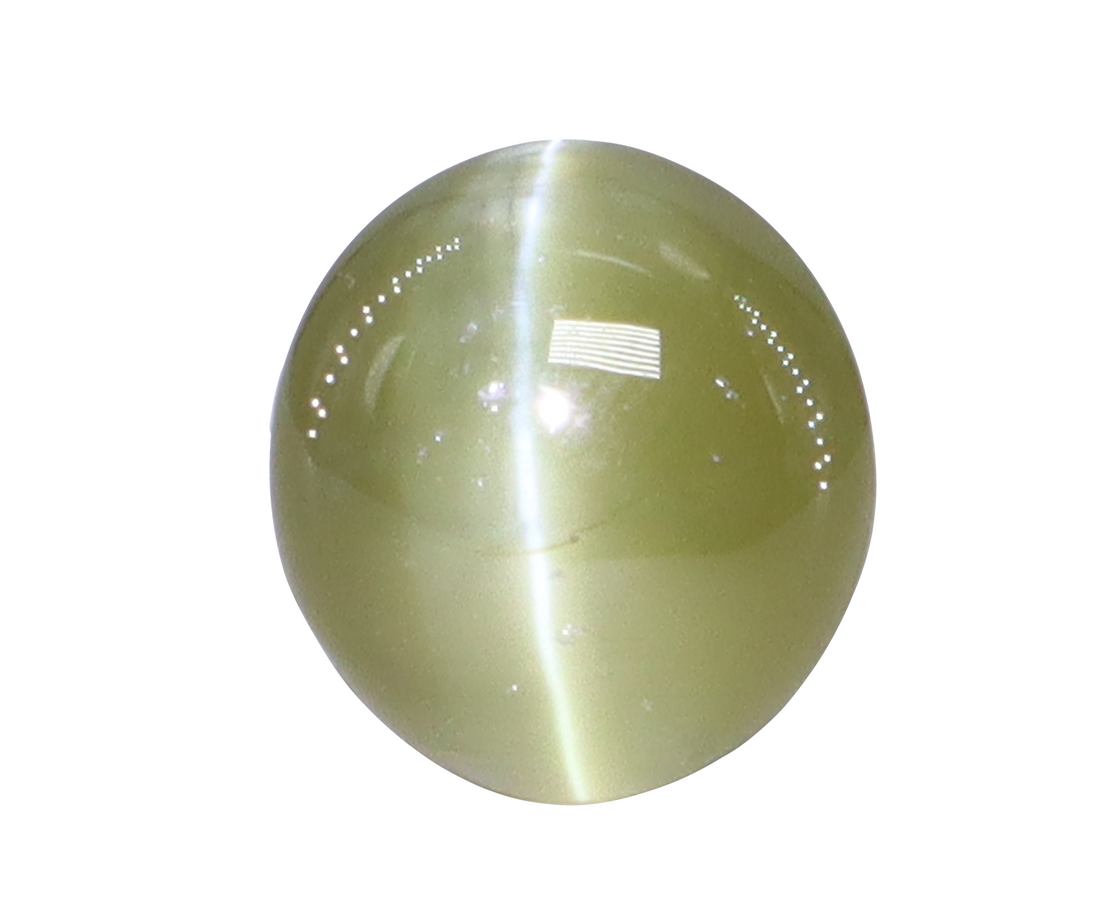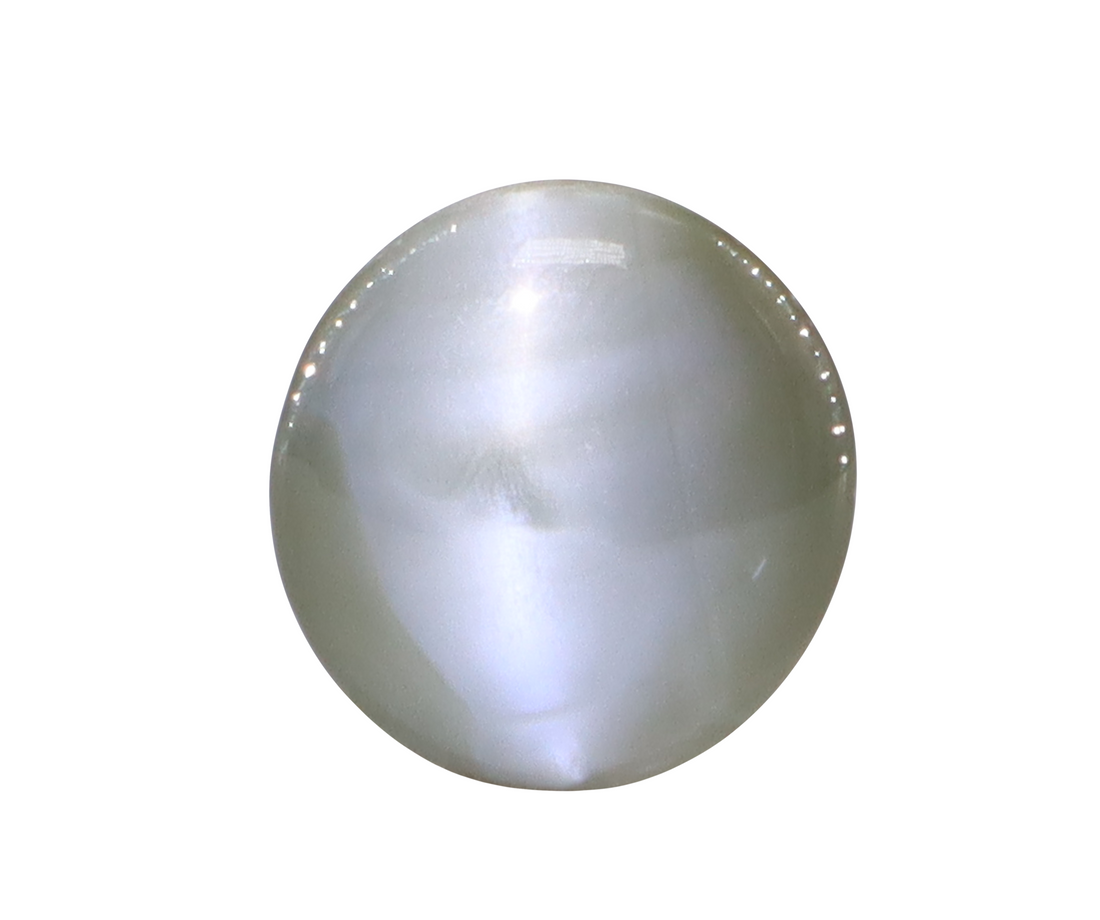This article serves as part of an ongoing series of profiles on the different varieties of precious & semi-precious gemstones. To view the entire list, click here.
Chrysoberyl cat's eye stones, or Lehsunia stone in Hindi – are marvels within the realm of gemstones, and possess an exquisite and enigmatic quality that sets them apart. Picture gazing into the heart of a velvety night, where a slender beam of light glimmers mysteriously, reminiscent of a feline's watchful gaze. These gems, known for their chatoyancy – which is a striking line of concentrated light that glides across the gem's surface – exude a captivating aura. Within the Precious Earth collection, these extraordinary gems find their place, enchanting enthusiasts with their rarity and allure.
It is interesting to note that the term “cat’s eye stone” in general refers to the chrysoberyl gem species. The chatoyance or the cat’s eye effect, however, is also seen in other different species of gemstones such as Moonstone cat’s eyes, Quartz cat’s eyes, Apatite cat’s eyes, etc. In this Precious Earth gem guide, we have compiled everything you need to know about the Chrysoberyl cat’s eye stone – including details about its origin, formation and occurrence, common treatments, price range, and more.
 The different types & classifications of cat’s eye stones
The different types & classifications of cat’s eye stones
1. Chrysoberyl Cat’s Eyes - Formation & Occurrence
Chrysoberyl cat's eye gemstones, renowned for their captivating chatoyant effect, are products of fascinating geological processes that span millennia. These remarkable gems are predominantly composed of beryllium aluminium oxide, a mineral compound found deep within the Earth's crust. Their formation primarily occurs in igneous and metamorphic environments, where extreme heat and pressure create the perfect conditions for their crystalline birth.
Predominantly, 2 types of chrysoberyl are notable in gemmological circles: ordinary chrysoberyl and alexandrite. Ordinary chrysoberyl, while not as visually spectacular as alexandrite, possesses its own allure. It is typically yellowish-green or brownish in colour and lacks the striking colour-change property. Alexandrite, on the other hand, is celebrated for its remarkable ability to shift colours under varying light sources. This phenomenon, known as pleochroism, gives alexandrite its chameleon-like quality, appearing green in daylight and transforming into a reddish hue under incandescent light.
 Rough chrysoberyl crystals (Source: IGI)
Rough chrysoberyl crystals (Source: IGI)
Easily the most notable feature of the chrysoberyl cat’s eye stone is its namesake – the chatoyance optical effect. This optical phenomenon results from the presence of needle-like inclusions, often composed of rutile or hematite, within the gem's crystalline structure. These inclusions align parallel to each other, creating a band of concentrated light that moves across the surface of the stone, mimicking the slit-eye appearance of a feline. This captivating display is attributed to the reflection and concentration of light caused by the aligned inclusions. Gem cutters carefully orient the gemstone to enhance this effect, which requires them to cut the stone en-cabochon, and polish only the top half of the gem while the bottom remains unpolished.
2. Where Are Chrysoberyl Cat’s Eyes Found?
Chrysoberyl cat's eye gemstones are found in various parts of the world, and their occurrence is often tied to specific geological environments. The primary locations where chrysoberyl cat's eyes are discovered include:
- Sri Lanka (Ceylon): This island nation is renowned for producing high-quality chrysoberyl cat's eye stones, often called Ceylonese cat’s eye stone in the trade. Sri Lanka's gem-rich soil and geological formations provide the ideal conditions for the formation of these gems. The Ratnapura district in particular is a famous hub for chrysoberyl cat's eye mining.
- India: Chrysoberyl cat's eyes are also found in India, especially in regions like Odisha and Tamil Nadu. India has a long history of gemstone mining, and chrysoberyl cat's eyes are among the treasures discovered in its mineral-rich land. This gem is particularly important in India, given its place as part of the popular navratna gems.
- Madagascar: This island nation is becoming increasingly known for its chrysoberyl cat's eye production. The discovery of these gems in Madagascar has added a new dimension to the global gemstone market, and currently, a major global supply of chrysoberyl cat’s eye stones comes from Madagascar.
- Brazil: Another significant source of chrysoberyl cat's eyes, Brazil boasts deposits that yield gems of various qualities. The Minas Gerais region is particularly notable for its chrysoberyl cat's eye production.
- Other Locations: Chrysoberyl cat's eyes can also be found in smaller quantities in regions such as Russia, China, and parts of Africa.
These gemstones are often unearthed through traditional mining methods, where miners extract them from alluvial deposits, veins, or pockets within rocks. The specific geological conditions of each region contribute to the unique characteristics and qualities of the chrysoberyl cat's eyes found there. As with any precious gemstone, the origin of a chrysoberyl cat's eye can play a role in determining its value and desirability within the market.
What is also interesting to note is that oftentimes, a lot of internationally recognised certification laboratories (such as IGI) refuse to specify the origin of a chrysoberyl cat’s eye in their certificates of authenticity. There are 2 reasons for this. First, given that these gems are usually opaque, it is difficult to study their internal inclusions and determine their origin. Second, and more importantly, chrysoberyl cat's eyes from Madagascar are often smuggled into Sri Lanka (Ceylon) and are mixed with Sri Lankan or Ceylonese cat's eyes, which are of higher value. As such, when such illegal and unethical mixing occurs, it becomes difficult to determine the origin of the gem.
3. The Colours of a Chrysoberyl Cat’s Eye
The colour range of chrysoberyl cat's eye gemstones is relatively limited compared to other gemstones, but it still offers a captivating spectrum of hues. The primary colour variations you'll find in chrysoberyl cat's eyes include:
- Golden to Greenish-Golden: The most common colour range for chrysoberyl cat's eyes is a golden to greenish-gold hue. These gems often exhibit a warm and inviting glow, resembling the play of sunlight on ripening wheat fields.
- Brownish-Green: Chrysoberyl cat's eyes with a brownish-green tone are also found. These gems can exhibit a more earthy and subdued appearance while still displaying the captivating cat's eye effect.
- Yellow to Honey: Some chrysoberyl cat's eyes lean more toward a pure yellow or honey colour. These gems exude a sense of warmth and can evoke feelings of sunshine and positivity.
 The different colours of a chrysoberyl cat’s eye stone: ranging from yellow-green to brownish-green
The different colours of a chrysoberyl cat’s eye stone: ranging from yellow-green to brownish-green
It's important to note that the colour of a chrysoberyl cat's eye gemstone, along with its clarity and the quality of the chatoyant effect, significantly impacts its value. The more intense and evenly distributed the colour, the more desirable the gem tends to be. Although the colour preference is subjective – in general, a green-yellow colour that is evenly saturated is the most desirable for a chrysoberyl cat’s eye stone and commands the highest prices.
4. Common Inclusions in Chrysoberyl Cat’s Eyes
Chrysoberyl cat's eye gemstones can exhibit various inclusions, which are naturally occurring internal features that form during the gem's growth process. Since these gems are uniquely opaque in general, these inclusions are often not visible to the naked eye, but are responsible for producing the chatoyance or the cat’s eye effect. Some common inclusions found in chrysoberyl cat's eyes include:
- Needle-like Inclusions: These are slender, elongated inclusions that often contribute to the cat's eye effect. When these needle-like inclusions are aligned parallel to each other, they create a distinct line of light that moves across the gem's surface.
- Rutile Needles: Rutile is a mineral that often forms in long, thin needle-like crystals. In chrysoberyl cat's eyes, rutile needles can play the primary role in producing the chatoyant cat’s eye effect. When cut and polished appropriately, they interact with light to create the shimmering band of light reminiscent of a cat's eye.
- Hematite Needles: Similar to rutile, hematite is another mineral that can form needle-like inclusions within the gem. Hematite needles can also contribute to the chatoyant effect, enhancing the gem's visual appeal.
- Silk Inclusions: Silk refers to the presence of fine, needle-like inclusions that can create a silky sheen when they intersect the surface of the gem. While not as commonly associated with chrysoberyl cat's eyes as in other gems, silk inclusions can occasionally be found.
- Other Inclusions: Other minerals and particles might also be present within chrysoberyl cat's eyes, such as apatite, zircon, and mica. These inclusions can vary in size, shape, and distribution.
It's worth noting that the presence and arrangement of inclusions, especially needle-like structures like rutile and hematite, play a crucial role in creating the cat's eye effect. Gemmologists and lapidaries often take these inclusions into account when cutting and shaping the gemstone to maximize the chatoyant effect. While inclusions are typically considered imperfections in many gemstones, in the case of chrysoberyl cat's eyes, they contribute to the gem's unique beauty and allure.
5. Common Treatments & Enhancements of Chrysoberyl Cat’s Eyes
Chrysoberyl cat’s eye stones are usually left untreated for the most part. This is because the cat’s eye effect can become less prominent on the stone if it has undergone some kind of treatment. As such, most of these gems are simply just cut into a cabochon, and are polished on the top. In very rare instances, they may be dyed or irradiated to enhance their colour, or oil-filled to improve their clarity. This is usually done to specimens that are of lower value.
| Mineral | Chrysoberyl |
|---|---|
| Colour Span | Yellow-Green, Brown-Green, Honey-Green |
| Popular Origins | Sri Lanka (Ceylon), India, Brazil, Madagascar |
| Mohs Hardness | 8.50 (on a scale of 10) |
| Common Treatments | Usually untreated; rarely dyed or oil-treated |
| Birthstone | June |
Chrysoberyl Cat’s Eye (Lehsuniya) - A Quick Snapshot
6. Evaluating the Quality of a Chrysoberyl Cat’s Eye
Evaluating the quality of a cat's eye stone involves considering a combination of factors that contribute to its overall appearance, rarity, and desirability. Here's a simplified guide to help you assess the quality of a chrysoberyl cat's eye gemstone:
- Chatoyancy Effect: The most distinctive feature of a cat's eye stone is its chatoyant effect, also known as the cat's eye effect. A high-quality cat's eye stone will display a sharp, well-defined, and centred band of light that moves smoothly across the surface when the stone is rotated. The band should be bright and easily visible under various lighting conditions. Oftentimes, this band of light is rather thick, blunt, and not very striking. Such specimens usually come at a lower cost, and in general, the sharper this cat’s eye effect, the more valuable the gem.
 2 distinct Ceylonese cat's eye stones: One with a sharp 'eye' (left) & one with a dull/blunt 'eye' (right)
2 distinct Ceylonese cat's eye stones: One with a sharp 'eye' (left) & one with a dull/blunt 'eye' (right)
- Colour: The colour of a chrysoberyl cat's eye can range from golden to greenish-gold, yellow to honey, and even brownish-green. The colour should be even and well-saturated. Avoid stones with dull or uneven colour distribution. In general, a light greenish-yellow tone is considered to be the most desirable.
- Origin: While gemmological certification reports might not specify the exact mine origin, knowing the general region where the stone was sourced can provide insights into its potential quality. Chrysoberyl cat's eyes from renowned sources like Sri Lanka and Madagascar are generally well-regarded.
- Size: Cat's eye stones come in various sizes, and personal preference plays a role in selecting the right size. Consider the stone's proportions in relation to its chatoyant band. Smaller stones might have a more concentrated chatoyant effect, while larger stones can exhibit a wider band.
- Cut & Shape: The cut of a cat's eye stone should be symmetrical and well-proportioned to maximize the chatoyant effect. The cabochon cut is the most common cut for cat's eye stones, featuring a smooth, convex surface. Ensure that the cut enhances the chatoyant line and allows it to move freely across the surface.
When evaluating a cat's eye stone, it's beneficial to view it under different lighting conditions to fully appreciate its chatoyant effect. If possible, seek the guidance of a knowledgeable jeweller or gemmologist who can provide insights based on their expertise. Remember that beauty is subjective, and selecting a cat's eye stone that resonates with your personal preferences is key to finding the perfect gem.
7. How Much Does Chrysoberyl Cat’s Eye Cost?
The price range of chrysoberyl cat's eye gemstones can vary significantly based on factors such as size, colour, quality of chatoyant effect, clarity, origin, and overall desirability. In general, however, the cost for a new chrysoberyl cat’s eye stone can begin as low as $75 per carat, and can go up to $2000 per carat for higher-quality specimens. For a reasonable standard quality of this gem, you can expect to spend between $250 - $400 per carat.
8. Cat’s Eyes in Astrology
Chrysoberyl cat's eye holds a distinctive place in the realm of astrology, known for its profound significance and celestial connections. This enchanting gemstone is closely associated with the power of Ketu, one of the nine celestial bodies in Vedic astrology. It is often referred to as "Lehsunia" or "Vaidurya" in Indian astrology. Chrysoberyl cat's eye is considered the birthstone for the month of June, making it particularly significant for individuals born during this time. This captivating gem is thought to bring about transformative energies, assisting individuals in breaking free from karmic cycles and gaining deeper insights into life's mysteries.
In astrology, the chrysoberyl cat's eye stone is believed to be especially beneficial for those born under the signs of Scorpio and Aquarius. The gem's unique connection with Ketu is thought to enhance intuition, spiritual growth, and protection from negative energies. Ketu's planetary influence is said to align with the gem's ability to enhance psychic abilities, intuition, and meditation practices. Wearing chrysoberyl cat's eye is believed to aid in dispelling illusions and guiding individuals towards higher consciousness.
 Cat’s eyes in Astrology
Cat’s eyes in Astrology
In general, a chrysoberyl cat’s eye stone is known to bring about the following benefits to its wearers:
- Protection & Dispelling Illusions: Chrysoberyl cat's eye is often regarded as a protective talisman against negative energies and psychic attacks. It's believed to create a shield of spiritual energy that safeguards the wearer from malevolent forces. Additionally, the gemstone is thought to assist in dispelling illusions and guiding individuals towards greater clarity and truth in their perceptions.
- Balanced Energy & Emotional Equilibrium: Chrysoberyl cat's eye is said to possess grounding energy that helps individuals stay balanced and centred. This grounding effect is thought to promote emotional equilibrium, helping to manage stress, anxiety, and negative emotions. By fostering a sense of stability, the gemstone is believed to encourage clear thinking and sound decision-making.
- Overcoming Challenges: Chrysoberyl cat's eye is believed to empower individuals in overcoming obstacles and challenges on their life journey. It's thought to provide a source of inner strength and resilience, enabling individuals to face adversity with determination and courage. The gemstone's transformative energies are said to inspire a positive outlook and a willingness to learn and grow from difficult experiences.
- Karmic Release & Transformation: With its association with Ketu, a celestial body in Vedic astrology linked to karma and spiritual evolution, the chrysoberyl cat's eye is believed to aid in breaking free from negative karmic patterns. Wearing this gemstone is thought to facilitate transformation, helping individuals release past burdens and embrace positive change in their lives.
It's important to remember that these benefits are based on traditional beliefs and are part of the metaphysical and astrological lore surrounding chrysoberyl cat's eye gemstones. As with any gemstone, individual experiences and beliefs may vary, and it's recommended to approach these notions with an open and respectful perspective.



